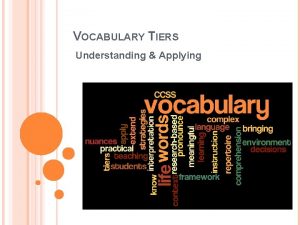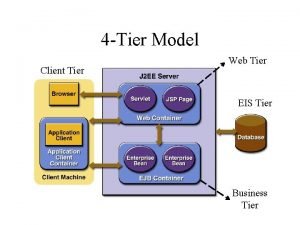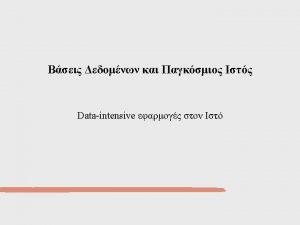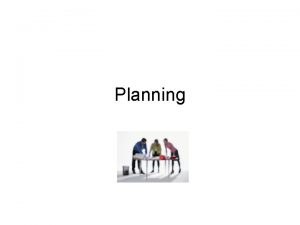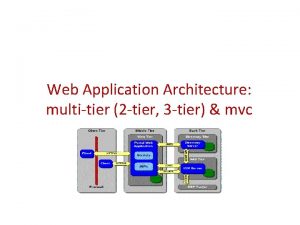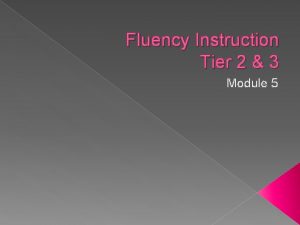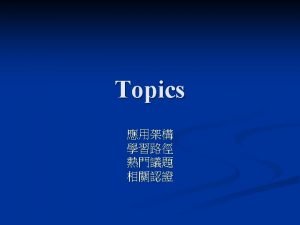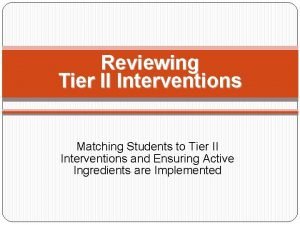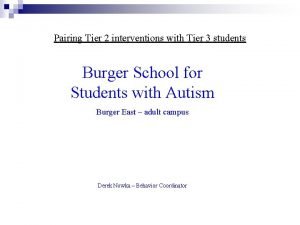Planning for Tier 2 TIER 1 2 or


















































- Slides: 50

Planning for Tier 2

TIER 1, 2, or 3? t ’ n e r a t a h t ls , t o l o u c h i f f i sc d Y e N A th t e r r o e p Are th ted to sup a v i t o m ? s d i k k Answer = NO at-ris So, why don’t we start with training? Tie r 2 in PB IS Answer = Need Tier 1 for Tier 2 to work

What is Tier 2 really about? t r o p p u s o t y a w a S k I s i I r t It ’ t s a N s t O n T e d u t I N s TERV just abo ut ENTI ONS It IS the SYSTEM that connects Tier 1 to Tier 3

Tier 1 Accomplishments ○ ○ ○ Students know behavior expectations System for acknowledging appropriate behavior Consistent response to behavior violations Team using data to make decisions District supporting efforts

SET What is Your Most Recent SET Score? 80% or higher total score School Wide Evaluation Tool (SET)

READINESS s e r o c s T E S r u o Do y ? s i h t s i h look t

READINESS h t o d r O this? s i h t k o o l y e

Who Might Benefit From Tier 2? Those students who do not sufficiently respond to Tier 1 strategies.

IMPORTANT MESSAGE e h t s f i o 1 N r e O i I T T A e D l g N n U a i O r F t S I B P e th So…. Be sure Tier 1 is solid, before investing in Tier 2 ☺

Tier 2 Examples of Tier 2 Interventions ○ ○ Check, Connect & Engage Organizational Check-up Social Skills Training Check-in/Check-out Are their others?

Let’s Evaluate • Take five minutes to review the programs available in your school for Tier 2

CRITICAL FEATURES Critical Features of Tier 2 ○ ○ ○ Continuously available to student Rapid access to intervention (72 hrs. ) Minimum effort for teacher/maximum benefit for student Consistent with school-wide expectations Implemented uniformly by all staff

CRITICAL FEATURES Critical Features of Tier 2 ○ ○ Flexible based on students needs/function Student chooses to participate Continuous progress monitoring Intervention “packages” matched to student need

BENEFITS Benefits of Tier 2 Interventions ○ ○ ○ ○ Improved structure Student is “set-up” for success Increase in contingent feedback Applied across school settings Increased reward for appropriate behavior Evolve to Self-management Supportive response to teacher

IDENTIFICATION Student Identification for Tier 2 ○ School ODR Referral – Teacher/Parent ○ Data decision rule ○ ○ ○ 3 -5 office referrals 2 Detentions 2 Suspensions Incomplete Work

Question? Are You Doing Some of This? Most schools have some supports available for students at risk. However, they often haven’t been systematically reviewed and connected. So, here’s what we should be considering…

PBIS TIER 1 Implemented Same Way as Tier 1 in Schools , 2, or 3? Implemented Same Way as Tier 1 in Schools

Data What Data Could Be Used? ODR ○ Suspensions ○ Attendance ○ Grades ○ Detentions ○ Minors ○ Intervention Data ○ DATA

SELECTION Selecting Students Office Discipline Referrals: Using Existing Data ○ Rule of Thumb = 2 to 7 ODRs ○ Not an immediate danger to self or others ○ What are the problem behaviors? ○ Matching behavior function to intervention

Systems What Systems Could Be Used? ○ ○ ○ Structured Team Meetings Nomination Process Progress Monitoring Fading Interventions Criteria For Moving Between Tiers SYSTEMS

Practices What Practices Could Be Used? ○ ○ ○ ○ Classroom Management CICO Check & Connect Social Skills Training Organizational Skills Homework Club Newcomer Club PRACTICES

Readiness Other Readiness Issues ○ ○ ○ Coordinator for Tier 2 supports (10 hrs. ) Commitment to train ALL staff Problem solving team ○ Can be PART of PBIS team, a regular function of WHOLE PBIS team, or a SEPARATE team ○ If separate, then plan to connection to Tier 1

Records and Decisions ○ Keep records of who is participating in each program ○ ○ ○ Name Progress Decision ○ ○ KIDS DON’T STAY IN THE PROGRAM INDEFINITELY!!! Follow-up AFTER they are removed from program

Steps for Identification for Tier 2 Interventions ○ ○ Select student – Data decision rule Enroll student in appropriate Tier 2 Interventions Monitor progress data Evaluate success/modify program ○ Fade the intervention or use more intense intervention

Interventions Now that We Identified the Students…What Interventions Should We Use? ○ ○ ○ Interventions should be directly linked to the student’s area of concern Targeted interventions should be “scientifically-based” Intervention content should be linked to the school-wide systems

Tier 2 Examples of Tier 2 Interventions ○ ○ Check, Connect & Engage Organizational Check-up Social Skills Training Check-in/Check-out

Check, Connect & Engage What is Check, Connect & Engage? ○ Check & Connect is a comprehensive intervention designed to enhance student engagement at school to assist disengaged students in grades K-12, through relationship building, problem solving and persistence. ○ Who Can Benefit? ○ Students who are skipping classes, frequent absenteeism, frequent number of school moves, limited extracurricular, those feeling socially isolated

Check, Connect & Engage Basic Approach ○ ○ Students: ○ Check in and out with Coach/ mentor ○ Receive systematic daily feedback from teachers ○ Receive weekly (up to daily) reinforcement for performance ○ Receive social skills and problem solving lessons as needed ○ Receive academic tutoring as needed Coaches/ mentors: ○ Serve as daily positive role models ○ Monitor all progress of students ○ Connect with student and all adults ○ Support teachers in implementing DPR effectively

Social Skills Training ○ Teaching and reinforcing specific skills for those students who demonstrate a skill deficit ○ Who Can Benefit? ○ Students who have the skills, but do not engage in it under the appropriate conditions.

Social Skills Training Basic Approach ○ ○ ○ Establish the Skill Identify the Components Provide a Model Rehearse the Skill Provide Feedback Program for Generalization

Organizational Check-Up ○ Facilitate student organization ○ Assist student with sorting and storing paperwork ○ Identifying assigned homework ○ Locate completed assignments ○ Who Can Benefit? ○ Students who turn in homework assignments and projects less 90% of the time across classes.

Organizational Check-Up Basic Approach ○ Spend time organizing the targeted areas ○ ○ ○ Locker Book Bag Binder – this is the most critical area for academic success Routinely check targeted areas using a checklist Fade intervention after student has earned 100% after 3 consecutive checks

The Behavior Education Program Check In / Check Out (CICO) Check In /Check Out (CICO) • Strong evidence-base – Over a dozen published studies – Works for 67% to 75% of ALL kids • Best for attention function but can be modified • Designed as a Tier 2 intervention • Can be purchased from Guilford Press as book and/or DVD

Critical Features • • Morning check-in Daily Progress Report (point card) Teacher feedback throughout the day Afternoon check-out Home component Team management and decision-making Training – Teachers – Students – Parent

Student Recommended for BEP Behavior Education Program BEP Implemented BEP Coordinator Summarizes Data for Decision Making Morning Check-In Regular Teacher Feedback Parent Feedback Biweekly Meeting to Assess Student Progress Afternoon Check-Out Revise Program Graduate Program

Morning Check-In • • • Students check-in with CICO manager Signed card from home is returned New card is delivered Point goal is reviewed Ensure student is ready for the day – Materials, homework

Daily Progress Report • One form used by all students – Not individualized • Connected to 3 -5 positively stated PBIS behavior expectations • Points are assigned for each behavior on a 0 -2 scale

HAWK Report Student ________Teacher__________ Date ____ 0 = No 1= Good 2= Excellent Check in check out card example Be Safe Be Respectful Keep hands, feet, and objects to self Use kind words and actions Be Your Personal Best Follow directions Class 0 1 2 Recess 0 1 2 Class 0 1 2 Lunch 0 1 2 Class 0 1 2 Recess 0 1 2 Class 0 1 2 Total Points = Points Possible = Today _______% 50 Teacher initials Work in class 0 1 2 Goal _______%

Check IN Check Out esample 2

Teacher Feedback Throughout the Day • Student is rated on behaviors during naturallyoccurring transitions • Feedback is brief – Verbal – Reward success and remind how score can improve if not scored as a 2 • By using same card for all kids, teachers don’t have to “individualize” things

Afternoon Check-Out • Check-out with CICO manager • Review points earned relative to goal • Deliver rewards – Daily? Progress toward larger goals? • CICO manager records points in database

Home Component • Daily Progress Report goes home to parent • Parent verbally rewards success – Avoid using as a punishment • Parent signs card and gives it back to student to return to school next day

Team Management and Decision. Making • Team meets biweekly to review CICO program • CICO Program Manager organizes data for meeting • Discuss students who are not succeeding • Plan for graduation for successful student – Fading

Decision-Making Cont’d: Importance of Baseline Data • Why? – So we know if the intervention helped • How to do it – Collect at least 3 to 5 days of data BEFORE the intervention begins • Teachers score behavior but don’t provide feedback to student

Tracking Student BEP Progress (number = % of total daily points) Date Jason Leanne Juan Kiran Alexa 1/16 85 95 100 80 65 1/17 100 100 75 77 1/18 77 0 100 85 63 1/19 45 75 95 92 85 1/20 88 89 77 89 90 1/23 79 0 100 95 95 1/24 95 67 85 100 78

Training • Teachers – Explain program to all teachers – Once they know how to rate behavior they can work with any kid • Students – Once student starts program, schedule a meeting to review program with student • Parents – When a student is being considered for program, talk to parents about what the program is for and how to manage signature and home feedback process

How Is BEP Different Than Other “Behavior Card” Interventions • A Targeted Intervention Implemented Within a School. Wide System of Behavior Support – Behavior Cards typically classroom interventions • Implemented in all settings, throughout the school day • All teachers and staff are trained • Students identified proactively and receive support quickly • Team uses data for decision making to determine progress 2005 by The Guilford Press

CICO Self-Assessment • Review what’s involved with doing a check in/ check out (CICO) program • If you choose to invest in CICO/BEP, then this document will help with action planning

Big Ideas Big ideas ○ ○ Tier 2 is a SYSTEM that connects Tier 1 to Tier 3 Not all schools that are interested in Tier 2 supports are ready ○ ○ ○ Invest in Tier 1 Select Tier 2 programs based on evidence Monitor progress of all students in Tier 2

Support Planning For More Support ○ If Tier 2 intervention and modified Tier 2 intervention do not lead to improvements for children, then the Tier 3 process should be initiated ○ Tier 3 = FBA that leads to individual behavior support plan
 Tier 1, 2 3 words examples
Tier 1, 2 3 words examples Tiers of academic vocabulary
Tiers of academic vocabulary Atmosfr
Atmosfr Vad är vanlig celldelning
Vad är vanlig celldelning Byggprocessen steg för steg
Byggprocessen steg för steg Tidbok yrkesförare
Tidbok yrkesförare Rutin för avvikelsehantering
Rutin för avvikelsehantering Myndigheten för delaktighet
Myndigheten för delaktighet Presentera för publik crossboss
Presentera för publik crossboss Rbk mätning
Rbk mätning Formuö
Formuö Kung dog 1611
Kung dog 1611 Tack för att ni har lyssnat
Tack för att ni har lyssnat Tobinskatten för och nackdelar
Tobinskatten för och nackdelar Stig kerman
Stig kerman Mall för referat
Mall för referat Epiteltyper
Epiteltyper Shingelfrisyren
Shingelfrisyren Karttecken
Karttecken Lufttryck formel
Lufttryck formel Vilket tal pekar pilen på
Vilket tal pekar pilen på Elektronik för barn
Elektronik för barn Borra hål för knoppar
Borra hål för knoppar Smärtskolan kunskap för livet
Smärtskolan kunskap för livet Bris för vuxna
Bris för vuxna Bra mat för unga idrottare
Bra mat för unga idrottare Anatomi organ reproduksi
Anatomi organ reproduksi Frgar
Frgar Vad är ett minoritetsspråk
Vad är ett minoritetsspråk Typiska novell drag
Typiska novell drag Magnetsjukhus
Magnetsjukhus Humanitr
Humanitr Toppslätskivling dos
Toppslätskivling dos Steg för steg rita
Steg för steg rita Hur skriver man en tes
Hur skriver man en tes Redogör för vad psykologi är
Redogör för vad psykologi är Claes martinsson
Claes martinsson En lathund för arbete med kontinuitetshantering
En lathund för arbete med kontinuitetshantering Ramsa geometriska former
Ramsa geometriska former Publik sektor
Publik sektor Exempel på lyrik
Exempel på lyrik Etik och ledarskap etisk kod för chefer
Etik och ledarskap etisk kod för chefer Antikt plagg
Antikt plagg Orubbliga rättigheter
Orubbliga rättigheter Densitet vatten
Densitet vatten Ministerstyre för och nackdelar
Ministerstyre för och nackdelar Big brother rösta
Big brother rösta Tack för att ni lyssnade bild
Tack för att ni lyssnade bild Tillitsbaserad ledning
Tillitsbaserad ledning Vem räknas som jude
Vem räknas som jude Ro i rom pax
Ro i rom pax
